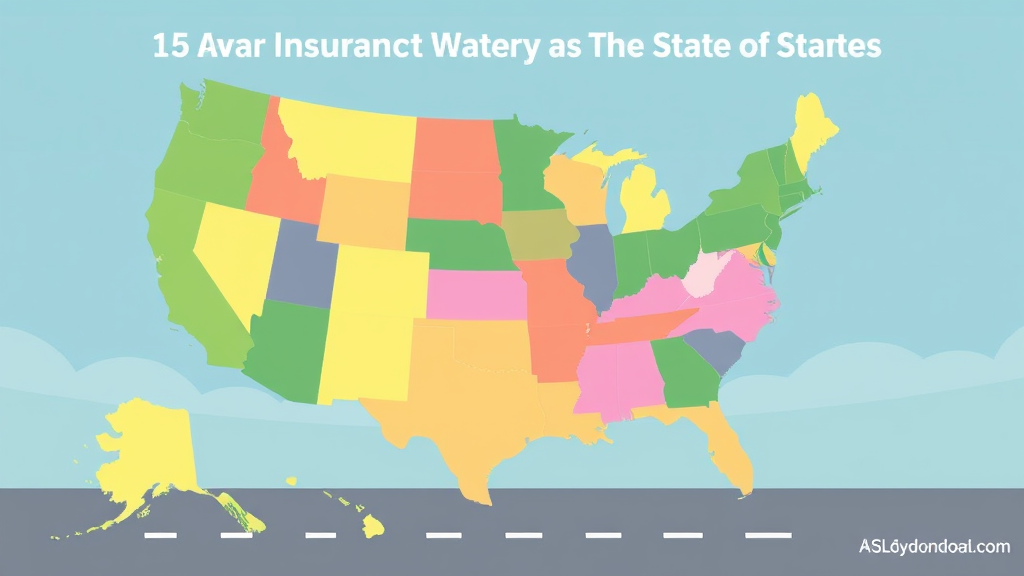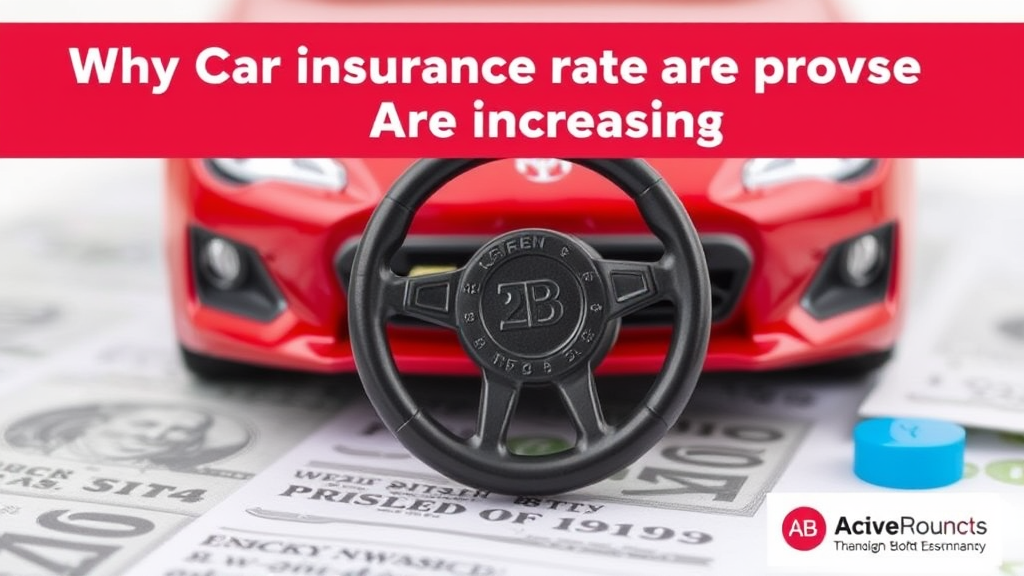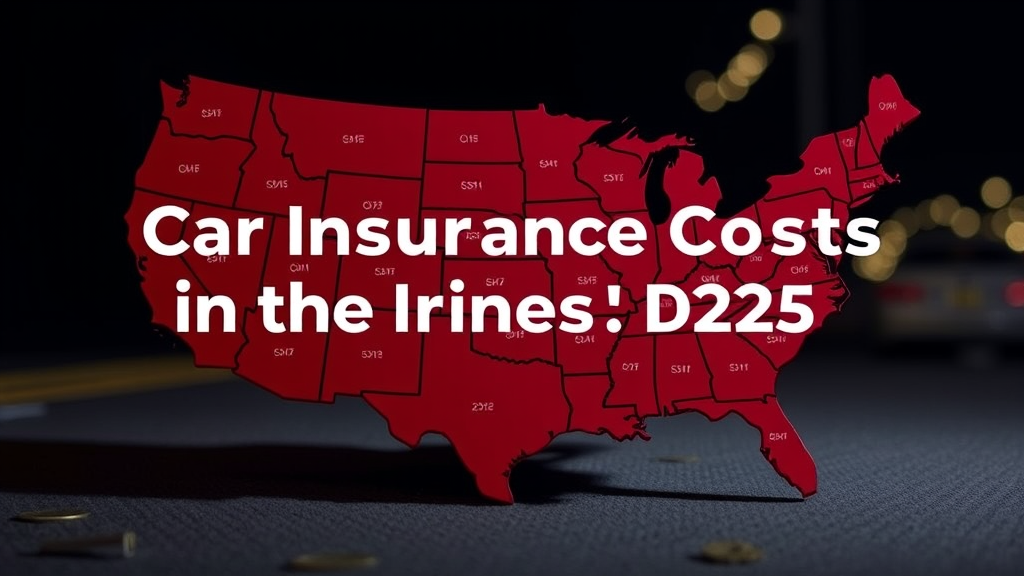Navigating the complexities of car insurance in the United States can be a daunting task, especially with ever-changing rates and a myriad of coverage options. For millions of American drivers, car insurance is not just a legal requirement but a crucial financial safeguard against the unforeseen. It provides essential protection against the costs associated with vehicle damage, injuries, and liabilities that can arise from accidents. However, recent years have seen a significant surge in insurance premiums, making it more challenging for consumers to find affordable coverage without compromising on necessary protection.
This comprehensive guide aims to demystify the world of car insurance in the USA for 2025. We will delve into the current landscape of auto insurance rates, explore the multifaceted factors that contribute to their fluctuations, and provide actionable insights into the various types of coverage available. More importantly, we will equip you with seven key strategies to help you save money on your car insurance, ensuring you get the best possible rates without sacrificing quality. Whether you’re a new driver, looking to switch providers, or simply seeking to understand your existing policy better, this article will serve as your ultimate resource for navigating the American car insurance market with confidence and clarity. Our information is meticulously gathered from reputable and up-to-date sources, ensuring accuracy and relevance for the current year and beyond.
Understanding Car Insurance Costs in the United States 2025

The cost of car insurance in the United States is a dynamic figure, influenced by a multitude of factors ranging from national economic trends to individual driver profiles. As of 2025, the national average cost for a full coverage car insurance policy has seen a notable increase, reaching approximately 2,638peryear,orabout2,638 per year, or about 220 per month.
This represents a 12 percent increase from 2024, continuing an upward trend observed over the past few years [Bankrate]. For minimum coverage policies, the average cost was around $740 per year in February 2024.
However, these national averages only tell part of the story. The true cost of car insurance can vary dramatically depending on where you live. This is often calculated by comparing the average annual full coverage car insurance premium to the median annual income for each state and metropolitan statistical area (MSA).
State-by-State Variations in Car Insurance Costs

Some states consistently rank as more expensive for car insurance due to a combination of factors such as higher population density, increased traffic, higher rates of vehicle theft, frequent extreme weather events, and prevalent insurance fraud. Conversely, states with lower population densities, fewer claims, and more favorable regulatory environments tend to have lower premiums.
According to data from, here’s a snapshot of the most and least expensive states for car insurance:
Most Expensive States for Car Insurance (2023/2025 data),
| State | Average Monthly Premium (The Zebra 2023) | Average Annual Premium (2025) |
| Michigan | $211 | (Not available in 2025) |
| Florida | $194 | $4,171 |
| Louisiana | $192 | $3,978 |
| Rhode Island | $156 | (Not available in Bankrate 2025) |
| Kentucky | $154 | (Not available in Bankrate 2025) |
Louisiana, for instance, consistently faces significant financial pressure from rising auto insurance rates, with drivers spending an average of 6.83% of their household income on car insurance, giving it the highest
true cost rank (50). Florida also consistently has higher average insurance costs, but with a significantly higher median income, the true cost of insurance is slightly lower than Louisiana, at 5.69% of household income.
Both states share similar risk characteristics, including high vehicle theft rates, frequent extreme weather losses, and high rates of insurance fraud, which contribute to their elevated premiums [Bankrate].
Least Expensive States for Car Insurance (2023/2025 data).
| State | Average Monthly Premium (The Zebra 2023) | Average Annual Premium (Bankrate 2025) |
| Ohio | $77 | (Not available in Bankrate 2025) |
| New Hampshire | $80 | (Not available in Bankrate 2025) |
| North Carolina | $84 | (Not available in Bankrate 2025) |
| Virginia | $86 | (Not available in Bankrate 2025) |
| Vermont | $88 | (Not available in Bankrate 2025) |
Hawaii stands out as having the lowest true cost of car insurance, with drivers spending only 1.77% of their income on car insurance, earning it a true cost rank.. Vermont and New Hampshire also rank highly for affordability, with drivers spending 1.81% and 1.88% of their median income on car insurance, respectively.
City-Specific Variations and Their Impact
Beyond state-level differences, car insurance costs can also vary significantly within metropolitan areas. For instance, Detroit, Michigan, has consistently been identified as the most expensive city for car insurance in the United States, with average premiums exceeding $6,000 per year, which is more than four times the national average. This is largely due to factors such as high population density, increased traffic congestion, and higher rates of vehicle theft and vandalism.
Conversely, cities like Winston-Salem, North Carolina, have some of the cheapest rates, averaging around
1,305 a year, while the Far West region is the most expensive, with an average rate of $1,665 a year. These regional and city-specific variations underscore the importance of considering your exact location when assessing potential car insurance costs.
Why Car Insurance Rates Are Increasing?

The consistent rise in car insurance rates across the United States is a multifaceted issue, driven by a combination of economic, environmental, and behavioral factors. Understanding these underlying causes is crucial for comprehending the current landscape of auto insurance premiums. Between 2020 and 2024, motor vehicle insurance rates in the U.S. saw a substantial increase of approximately 54%. This significant surge can be attributed to several key elements:
1. Inflation and Rising Costs of Repairs and Parts
One of the primary drivers behind escalating car insurance premiums is the pervasive impact of inflation on the automotive industry. The cost of repairing vehicles and replacing parts has soared in recent years. For instance, from June 2023 to June 2024, the price of personal motor vehicle insurance alone rose by 19.5%. This is directly linked to the increased expenses faced by repair shops for labor, materials, and advanced technology components found in modern vehicles. When the cost of claims increases for insurance companies, these higher expenses are inevitably passed on to consumers through increased premiums.
2. Insurers’ Investment Returns and Interest Rate Fluctuations
Insurance companies generate revenue not only from premiums but also from investing the premiums they collect. Fluctuations in interest rates can significantly impact their profitability. When interest rates are low, the returns on these investments decrease, putting pressure on insurers to compensate for this reduced income. For example, when the Federal Reserve increased interest rates in 2022, there was a noticeable decline in the value of insurers’ bond investments, affecting their overall financial stability. To offset these losses and maintain profitability, insurance companies may opt to raise the price of existing policies.
3. Individual Risk Factors
While broader economic factors play a significant role, individual driver characteristics and behaviors are also critical determinants of car insurance rates. Insurers assess a variety of personal risk factors to calculate premiums, including:
•Age and Gender: Younger drivers, particularly males under 25, typically face higher rates due to a statistically higher risk of accidents. Rates generally stabilize as drivers mature but may increase again for seniors as accident risks rise.
•Marital Status: Married individuals are often considered less likely to be involved in accidents, which can lead to lower premiums compared to single drivers.
•Vehicle Type: The make, model, and year of a vehicle significantly influence insurance costs. High-performance cars, luxury vehicles, and those with expensive parts or advanced technology tend to have higher premiums because they are more costly to repair or replace, and may be more attractive targets for theft. For example, vans are generally cheaper to insure than sedans.
•Location: Where a driver lives and parks their vehicle has a substantial impact on rates. Urban areas with higher traffic density, increased crime rates (theft and vandalism), and more frequent accidents typically have higher insurance premiums. Conversely, rural or less populated areas often see lower rates.
•Driving Patterns: The more miles a driver accumulates annually, the higher their perceived risk of an accident, leading to increased premiums. Reducing annual mileage can potentially lead to savings.
•Driving Record: A history of accidents, traffic violations (such as speeding tickets or DUIs), or previous insurance claims can significantly elevate premiums. Insurers view these as indicators of higher future risk. For instance, a hit-and-run citation can have the biggest impact on premiums.
•Credit History: In many states, an individual’s credit score can influence their insurance rates. Those with lower credit scores may be offered higher premiums due to a perceived correlation with financial instability and a higher likelihood of filing claims.
4. State-Specific Regulations
The regulatory environment within each state also plays a role in shaping car insurance rates. Some states have stringent regulatory frameworks that can delay or moderate rate increases, aiming to protect consumers. Other states with more flexible regulations allow insurers to adjust rates more swiftly in response to market changes and rising costs. These varying regulatory approaches contribute to the significant differences in premiums observed across states.
In summary, the rising cost of car insurance is a complex interplay of macroeconomic factors like inflation and interest rates, coupled with individual risk profiles and state-specific regulations. As these elements continue to evolve, so too will the landscape of car insurance premiums in the United States.
Essential Types of Car Insurance Coverage
Understanding the different types of car insurance coverage is fundamental to making informed decisions about your policy. While specific requirements vary by state, most car insurance policies in the United States offer a combination of coverages designed to protect you financially in various scenarios. Here are the essential types of car insurance coverage:
1. Liability Coverage
Liability coverage is the most basic and often legally required type of car insurance. It protects you financially if you are at fault in an accident that causes bodily injury to others or damage to their property. It typically has two components:
•Bodily Injury Liability: Covers medical expenses, lost wages, and pain and suffering for people injured in an accident you cause. It also covers legal fees if you are sued.
•Property Damage Liability: Covers the cost of repairs or replacement for property you damage in an accident, such as another vehicle, a fence, or a building.
Most states mandate a minimum amount of liability coverage, but it’s often advisable to carry more than the minimum to adequately protect your assets in case of a serious accident.
2. Collision Coverage
Collision coverage pays for damage to your own vehicle resulting from a collision with another vehicle or object, regardless of who is at fault. This includes damage from hitting a tree, a pole, or another car. If you have a car loan or lease, your lender will typically require you to carry collision coverage to protect their investment.
3. Comprehensive Coverage
Comprehensive coverage protects your vehicle from damage caused by events other than collisions. This includes incidents such as theft, vandalism, fire, natural disasters (like hail, floods, or hurricanes), falling objects, and damage from striking an animal. Like collision coverage, comprehensive coverage is often required by lenders for financed or leased vehicles.
4. Uninsured/Underinsured Motorist Coverage (UM/UIM)
Despite legal requirements, many drivers on the road are uninsured or carry insufficient insurance to cover the costs of an accident. Uninsured/Underinsured Motorist (UM/UIM) coverage protects you and your passengers if you are involved in an accident with a driver who has no insurance or not enough insurance to cover your damages. It typically covers:
- Uninsured Motorist Bodily Injury (UMBI): Covers medical expenses and lost wages for you and your passengers.
- Uninsured Motorist Property Damage (UMPD): Covers damage to your vehicle.
- Underinsured Motorist (UIM): Kicks in when the at-fault driver has some insurance, but not enough to cover the full extent of your damages.
5. Personal Injury Protection (PIP) / Medical Payments (MedPay)
Personal Injury Protection (PIP) and Medical Payments (MedPay) coverage help pay for medical expenses for you and your passengers, regardless of who is at fault for an accident. The key differences are:
•Personal Injury Protection (PIP): Available in
no-fault states and covers medical expenses, lost wages, and in some cases, funeral expenses for you and your passengers, regardless of who caused the accident.
•Medical Payments (MedPay): Available in at-fault states and covers medical expenses for you and your passengers, regardless of fault, but typically does not cover lost wages or other non-medical expenses.
Understanding these core coverages is the first step towards building a car insurance policy that adequately protects you and your assets on American roads. It is always recommended to consult with an insurance professional to determine the best coverage for your specific needs and state requirements.
7 Essential Tips to Save Money on Car Insurance
With car insurance rates on the rise, finding ways to reduce your premiums without sacrificing essential coverage has become a top priority for many American drivers. Here are seven effective strategies to help you save money on your car insurance:
1. Compare Quotes from Multiple Insurers
This is arguably the most impactful step you can take to lower your car insurance costs. Insurance companies use different algorithms and risk assessments, leading to significant variations in quotes for the same coverage. Shopping around and comparing offers from at least three to five different providers can reveal substantial savings. Websites and independent agents can help you quickly gather multiple quotes. Even if you’re happy with your current insurer, it’s wise to compare quotes annually or whenever your policy is up for renewal to ensure you’re still getting the best deal.
2. Increase Your Deductibles
A deductible is the amount of money you agree to pay out-of-pocket before your insurance coverage kicks in after a claim. By choosing a higher deductible for your collision and comprehensive coverages, you can significantly lower your premium. For example, increasing your deductible from 500to500 to 1,000 could lead to noticeable savings on your annual premium. However, ensure you have enough money saved to cover the higher deductible in case you need to file a claim.
3. Take Advantage of Available Discounts
Insurance companies offer a wide array of discounts that can help reduce your premiums. It’s crucial to ask your insurer about all available discounts and see which ones you qualify for. Common discounts include:
•Safe Driver/Good Driver Discount: For drivers with a clean driving record, free of accidents or violations for a certain period.
•Multi-Policy Discount: Bundling your car insurance with other policies, such as home or renters insurance, with the same provider.
•Multi-Car Discount: Insuring multiple vehicles on the same policy.
•Good Student Discount: For high school or college students who maintain a certain GPA.
•Defensive Driving Course Discount: Completing an approved defensive driving course.
•Low Mileage Discount: For drivers who drive fewer miles annually than the average.
•Anti-Theft Device Discount: For vehicles equipped with anti-theft systems.
•Payment Discounts: For paying your premium in full, setting up automatic payments, or opting for paperless billing.
4. Maintain a Clean Driving Record
Your driving record is one of the most significant factors influencing your insurance rates. Accidents, speeding tickets, and other traffic violations signal to insurers that you are a higher risk, leading to increased premiums. Conversely, maintaining a clean driving record demonstrates responsible driving habits, which can qualify you for safe driver discounts and lower rates over time. Avoid distractions while driving and adhere to traffic laws to keep your record spotless.
5. Choose the Right Vehicle
The type of vehicle you drive plays a substantial role in determining your insurance costs. Cars that are expensive to repair, frequently stolen, or have high performance capabilities typically come with higher insurance premiums. Before purchasing a new car, research its insurance costs. Opting for a vehicle with a strong safety record, lower repair costs, and less appeal to thieves can lead to significant long-term savings on your insurance. For example, vans are generally cheaper to insure than sedans.
6. Reduce Your Annual Mileage
The more you drive, the higher the likelihood of being involved in an accident. Many insurance companies offer discounts for low-mileage drivers. If you work from home, use public transportation, or have a short commute, inform your insurer. Reducing your annual mileage from 15,000 to less than 7,500 miles per year could save you around 6% on your premium.
7. Review Your Policy Regularly
Your life circumstances change, and so should your insurance policy. Review your coverage at least once a year, or whenever a significant life event occurs (e.g., marriage, moving, new job, children turning driving age). You might be paying for coverage you no longer need, or you might qualify for new discounts. For instance, if your car is older and its value has depreciated significantly, you might consider dropping collision or comprehensive coverage to save money.
By implementing these strategies, you can proactively manage your car insurance costs and ensure you’re getting the most value for your money in the competitive U.S. market.
Statistics and Important Facts about Car Insurance in the United States
The U.S. car insurance market is a dynamic sector, constantly evolving with economic shifts, technological advancements, and changes in driving behaviors. Here are some key statistics and important facts that highlight the current state and trends within the industry:
1. Rate Increases Over Time
Car insurance rates have been on a significant upward trajectory over the past decade. Since 2011, rates have skyrocketed by 29.6% nationally. More recently, between 2020 and 2024, motor vehicle insurance rates rose by approximately 54%. This acceleration in premium increases is a direct reflection of rising claims costs, driven by factors such as inflation, more expensive vehicle repairs, and an increase in accident frequency and severity.
2. Impact of Driving Violations on Premiums
Your driving record is a paramount factor in determining your car insurance premiums. Insurers heavily penalize drivers with a history of violations, as these indicate a higher risk of future claims. For instance, a citation for leaving the scene of an accident (hit and run) has the most severe impact on auto insurance premiums, consistently topping the list of violations that lead to the highest rate increases. Even less severe infractions, such as getting caught texting or using your phone while driving, can lead to a significant average increase of 23% in your insurance rate, with some states seeing increases of over 63%. This underscores the financial consequences of unsafe driving habits.
3. Influence of Vehicle Type on Insurance Costs
Not all vehicles are insured equally. The make, model, and even the body type of your car can significantly influence your insurance premiums. Generally, vehicles that are more expensive to repair, have higher theft rates, or are considered high-performance cars will incur higher insurance costs. Conversely, vehicles that are less attractive to thieves, have readily available and affordable parts, and are less prone to high-speed accidents tend to be cheaper to insure.
•Most Expensive to Insure: In 2023, the Maserati Quattroporte was identified as one of the most expensive cars to insure, costing an average of $419 per month, which is 239% more than the national average.
•Vehicle Type Comparison: Vans are typically the cheapest car type to insure, with annual premiums averaging around 1,688.Sedans,ontheotherhand,areamongthemostexpensive,withaveragecostsreaching1,688. Sedans, on the other hand, are among the most expensive, with average costs reaching 2,275 per year.
•Eco-Friendly Cars: Surprisingly, green or hybrid cars can also be more expensive to insure, averaging around $2,110 per year. This is primarily due to the higher cost of specialized parts and repairs associated with their advanced technology.
These statistics highlight the importance of considering insurance costs when purchasing a vehicle, as they can significantly impact your overall ownership expenses.
Frequently Asked Questions (FAQs)
Here are some common questions about car insurance in the United States:
Q1: What is the average cost of car insurance in the United States?
A1: As of 2025, the national average cost for a full coverage car insurance policy is approximately 2,638peryear,orabout2,638 per year, or about 220 per month [Bankrate]. However, this can vary significantly based on individual factors and location.
Q2: What factors affect car insurance rates?
A2: Many factors influence car insurance rates, including age, gender, marital status, vehicle type, location, driving record (accidents, violations), credit history, and the type and amount of coverage chosen. Economic factors like inflation and interest rates also play a role.
Q3: How can I get cheaper car insurance?
A3: To save money on car insurance, you can compare quotes from multiple insurers, increase your deductibles, take advantage of available discounts, maintain a clean driving record, choose a vehicle that is cheaper to insure, reduce your annual mileage, and regularly review your policy [See Section 5 for more details].
Q4: Is car insurance mandatory in all states?
A4: In almost every U.S. state, car insurance is a mandatory requirement to legally drive a vehicle. The specific minimum coverage requirements vary by state. Only a few exceptions exist where financial responsibility can be proven through other means.
Q5: What is the difference between comprehensive and liability insurance?
A5: Liability insurance covers damages and injuries you cause to other people and their property in an at-fault accident. It does not cover damage to your own vehicle. Comprehensive insurance covers damage to your own vehicle from non-collision events, such as theft, vandalism, fire, natural disasters, or hitting an animal. It does not cover damages you cause to others.
Q6: What should I do if I get into a car accident?
A6: If you get into a car accident, first ensure everyone’s safety and call for emergency services if needed. Exchange information with the other driver (name, contact, insurance details). Document the scene with photos and notes. Report the accident to your insurance company as soon as possible. Follow their instructions for filing a claim.
Conclusion
Car insurance in the United States is a complex yet indispensable aspect of vehicle ownership. As we have explored, the landscape of auto insurance is continually shaped by a confluence of economic forces, individual driving behaviors, and regulatory frameworks. The rising costs, influenced by factors such as inflation, increasing repair expenses, and fluctuating investment returns for insurers, underscore the importance of being an informed consumer.
Understanding the various types of coverage—from essential liability to comprehensive and collision—empowers you to select a policy that not only meets legal requirements but also provides adequate financial protection for your specific needs. More critically, by actively implementing strategies such as comparing quotes, adjusting deductibles, leveraging discounts, maintaining a clean driving record, and making informed vehicle choices, you can significantly mitigate the impact of rising premiums.
Ultimately, securing the right car insurance policy is about more than just fulfilling a legal obligation; it’s about safeguarding your financial well-being and ensuring peace of mind on the road. By staying informed, proactive, and diligent in your approach, you can navigate the U.S. car insurance market effectively, securing valuable coverage at the most competitive rates. Drive safely, stay insured, and make informed decisions to protect your journey.

